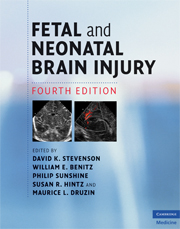Book contents
- Frontmatter
- Contents
- List of contributors
- Foreword
- Preface
- Section 1 Epidemiology, pathophysiology, and pathogenesis of fetal and neonatal brain injury
- Section 2 Pregnancy, labor, and delivery complications causing brain injury
- Section 3 Diagnosis of the infant with brain injury
- Section 4 Specific conditions associated with fetal and neonatal brain injury
- Section 5 Management of the depressed or neurologically dysfunctional neonate
- 39 Neonatal resuscitation: immediate management
- 40 Improving performance, reducing error, and minimizing risk in the delivery room
- 41 Extended management following resuscitation
- 42 Endogenous and exogenous neuroprotective mechanisms after hypoxic–ischemic injury
- 43 Neonatal seizures: an expression of fetal or neonatal brain disorders
- 44 Nutritional support of the asphyxiated infant
- Section 6 Assessing outcome of the brain-injured infant
- Index
- Plate section
- References
39 - Neonatal resuscitation: immediate management
from Section 5 - Management of the depressed or neurologically dysfunctional neonate
Published online by Cambridge University Press: 12 January 2010
- Frontmatter
- Contents
- List of contributors
- Foreword
- Preface
- Section 1 Epidemiology, pathophysiology, and pathogenesis of fetal and neonatal brain injury
- Section 2 Pregnancy, labor, and delivery complications causing brain injury
- Section 3 Diagnosis of the infant with brain injury
- Section 4 Specific conditions associated with fetal and neonatal brain injury
- Section 5 Management of the depressed or neurologically dysfunctional neonate
- 39 Neonatal resuscitation: immediate management
- 40 Improving performance, reducing error, and minimizing risk in the delivery room
- 41 Extended management following resuscitation
- 42 Endogenous and exogenous neuroprotective mechanisms after hypoxic–ischemic injury
- 43 Neonatal seizures: an expression of fetal or neonatal brain disorders
- 44 Nutritional support of the asphyxiated infant
- Section 6 Assessing outcome of the brain-injured infant
- Index
- Plate section
- References
Summary
Introduction
Despite the fact that recent studies suggest that postpartum events account for only a fraction of untoward outcomes such as cerebral palsy, mental retardation, and chronic seizure disorders, management of the newborn during the immediate postpartum period is often subject to rigorous scrutiny by malpractice attorneys and their medical consultants. Because the potential for cerebral injury during the intrapartum period is real, it is critical that evidence-based principles of neonatal resuscitation as described in the Neonatal Resuscitation Program (NRP) of the American Academy of Pediatrics (AAP) be applied in an effort to attenuate or even reverse pathologic processes originating in utero.
Adequate maternal cardiac output and arterial oxygen content, in addition to a functioning placenta, serve to support the metabolic needs of the fetus. Disruption of oxygen supply to the fetus may have consequences after birth depending on the severity and duration of decreased oxygen delivery. Anything that impacts the health of the pregnant woman may also have adverse effects on the fetus. Fetal oxygen delivery may be impaired by poor maternal cardiopulmonary function such as that seen in cystic fibrosis and cardiomyopathy; altered uterine blood flow as in maternal hemorrhage; chronically or acutely diminished placental perfusion due to pregnancy-induced hypertension and uterine hyperstimulation; or umbilical cord dysfunction as in umbilical cord prolapse. Detection of fetal stress during the intrapartum period relies mainly on monitoring of the fetal heart rate. When a non-reassuring fetal heart rate is present, maneuvers to restore adequate oxygen delivery to the fetus are indicated.
- Type
- Chapter
- Information
- Fetal and Neonatal Brain Injury , pp. 453 - 463Publisher: Cambridge University PressPrint publication year: 2009

